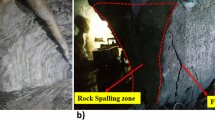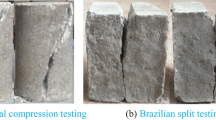Abstract
The Niagara Tunnel Project (NTP) is a 10.1 km long water-diversion tunnel in Niagara Falls, Ontario, which was excavated by a 7.2 m radius tunnel boring machine. Approximately half the tunnel length was excavated through the Queenston Formation, which locally is a shale to mudstone. Typical overbreak depths ranged between 2 and 4 m with a maximum of 6 m observed. Three modelling approaches were used to back analyse the brittle failure process at the NTP: damage initiation and spalling limit, laminated anisotropy modelling, and ubiquitous joint approaches. Analyses were conducted for three tunnel chainages: 3 + 000, 3 + 250, and 3 + 500 m because the overbreak depth increased from 2 to 4 m. All approaches produced similar geometries to those measured. The laminated anisotropy modelling approach was able to produced chord closures closest to those measured, using a joint normal to shear stiffness ratio between 1 and 2. This understanding was applied to a shaft excavation model in the Queenston Formation at the proposed Deep Geological Repository (DGR) site for low and intermediate level nuclear waste storage in Canada. The maximum damage depth was 1.9 m; with an average of 1.0 m. Important differences are discussed between the tunnel and shaft orientation with respect to bedding. The models show that the observed normalized depth of failure at the NTP would over-predict the depth of damage expected in the Queenston Formation at the DGR.





















Similar content being viewed by others
Abbreviations
- a p :
-
Peak Hoek–Brown material constant
- a r :
-
Residual Hoek–Brown material constant
- CI:
-
Crack initiation
- E :
-
Intact rock modulus
- E beam :
-
Beam modulus (material between joint elements)
- Erm:
-
Rock mass modulus
- K Hh :
-
Maximum-to-minimum horizontal stress ratio
- K hv :
-
Minimum horizontal-to-vertical stress ratio
- K N :
-
Joint/lamination normal stiffness
- K o :
-
Maximum horizontal-to-vertical stress ratio
- K S :
-
Joint/lamination shear stiffness
- m p :
-
Peak Hoek–Brown material constant
- m r :
-
Residual Hoek–Brown material constant
- p 0 :
-
Hydrostatic in situ stress
- p i :
-
Internal support pressure
- r :
-
Maximum overbreak depth
- R :
-
Radius of the excavation
- S :
-
Joint/lamination spacing
- s p :
-
Peak Hoek–Brown material constant
- s r :
-
Residual Hoek–Brown material constant
- T :
-
Tensile strength
- UCS:
-
Unconfined compressive strength
- u ie :
-
Elastic excavation convergence
- σ 1 :
-
Maximum principal stress
- σ 3 :
-
Minimum principal stress
- σ H :
-
Maximum horizontal stress
- σ max :
-
Maximum tangential stress at an excavation boundary
- σ v :
-
Vertical stress
- υ :
-
Poisson’s ratio
- ϕ :
-
Friction angle
- ψ :
-
Dilation angle
- AECL:
-
Atomic Energy of Canada Ltd
- BTS:
-
Brazilian tensile strength
- DGR:
-
Deep geological repository
- DISL:
-
Damage initiation and spalling limit
- DTS:
-
Direct tensile strength
- EDZi:
-
Inner excavation damage zone
- EDZo:
-
Outer excavation damage zone
- GSI:
-
Geological strength index
- HDZ:
-
Highly damaged zone
- LAM:
-
Laminated Anisotropy Modelling
- NTP:
-
Niagara tunnel project
- NWMO:
-
Nuclear Waste Management Organization of Canada
- SAB:
-
Sir Adam Beck generating station
- TBM:
-
Tunnel boring machine
- UBJT DY:
-
Ubiquitous joint double yield
References
Amann F, Button EA, Evans KF, Gischig VS, Blumel M (2011) Experimental study of the brittle behaviour of clay shale in rapid unconfined compression. Rock Mech Rock Eng 44:415–430. doi:10.1007/s00603-011-0156-3
Armstrong DK, Carter TR (2006) An updated guide to the subsurface Paleozoic stratigraphy of southern Ontario. Ont Geol Surv Open File Rep 6191:214
Armstrong DK, Carter TR (2010) The subsurface Paleozoic stratigraphy of southern Ontario. Ont Geol Surv (Special Vol. 7)
Barla G, Bonini M, Semeraro M (2011) Analysis of the behaviour of a yield-control support system in squeezing rock. Tunn Undergr Sp Technol 26:146–154. doi:10.1016/j.tust.2010.08.001
Barton N (2007) Rock quality, seismic velocity, attenuation and anisotropy. Taylor and Francis Group, New York, p 720
Bergstrom SM, Kleffner M, Schmitz B, Cramer BD (2011) Revision of the position of the Ordovician-Silurian boundary in southern Ontario: regional chronostratigraphic implications of 13C chemostratigraphy of the Manitoulin Formation and associated strata. Can J Earth Sci 48:1447–1470. doi:10.1139/E11-039
Brady BHG, Brown ET (2006) Rock Mechanics for underground mining, 3rd edn. Springer, Dordrecht, The Netherlands
Brogly PJ, Martini IP, Middleton GV (1998) The Queenston Formation: shale dominated, mixed terrigenous-carbonate deposits of Upper Ordovician, semi-arid, muddy shores in Ontario, Canada. Can J Earth Sci 35:702–719. doi:10.1139/e98-021
Delmar R, Charalmbu H, Gschnitzer E, Everdell R (2006) The Niagara Tunnel Project–an overview. Tunn Association of Can Conference, Niagara Falls, Canada
Diederichs MS (2003) Rock fracture and collapse under low confinement conditions. Rock Mech Rock Eng 36(5):339–381. doi:10.1007/s00603-003-0015-y
Diederichs MS (2007) The 2003 Canadian geotechnical colloquium: mechanistic interpretation and practical application of damage and spalling prediction criteria for deep tunnelling. Can Geotech J 44:1082–1116. doi:10.1139/T07-033
Diederichs MS, Martin CD (2010) Measurement of spalling parameters from laboratory testing. In: Proceedings of Eurock, Lausanne, Switzerland
Fortsakis P, Nikas K, Marinos V, Marinos P (2012) Anisotropic behaviour of stratified rock masses in tunnelling. Eng Geol 141–142:74–83. doi:10.1016/j.enggeo.2012.05.001
Ghazvinian E, Perras M, Diederichs M, Labrie D (2013) The effect of anisotropy on crack damage thresholds in brittle rocks. In: Proceedings ARMA 2013, San Francisco, CA, USA
Gorski B, Anderson T, Conlon B (2009) DGR site characterization documents, technical reports TR-07-03 and TR-08-11. www.nwmo.ca. Accessed 24 Mar 2014
Gorski B, Anderson T, Conlon B (2010) DGR site characterization documents, technical reports TR-08-24 and TR-08-36. www.nwmo.ca. Accessed 21 Feb 2014
Gorski B, Rodgers D, Conlon B (2011) DGR site characterization document, technical report TR-09-07. www.nwmo.ca. Accessed 10 Nov 2011
Gross MR, Fischer MP, Engelder T, Greenfield RJ (1995) Factors controlling joint spacing in interbedded sedimentary rocks: integrating numerical models with field observations from the Monterey Formation, USA. Geol Society, Lond, Spec Publications 92:215–233. doi:10.1144/GSL.SP.1995.092.01.12
Gschnitzer E, Goliasch (2009) TBM modification for challenging rock conditions—a progress report of the Niagara Tunnel Project (NTP). Geomech Tunn 2(2):168–178. doi:10.1002/geot.2009000016
Haimson BC (1983) SAB-Niagara GS No. 3 hydrofracturing stress measurements and permeability tests in holes NF-3 and NF-4. Ontario Hydro Report: 85357
Hajiabdolmajid VR (2001) Mobilization of strength in brittle failure of rock. PhD thesis, Queen’s University, Kingston, Ontario, Canada
Hajiabdolmajid V, Kaiser PK, Martin CD (2002) Modelling brittle failure of rock. Int J Rock Mech Min Sci 39:731–741. doi:10.1016/S1365-1609(02)00051-5
Hoek E, Brown T (1997) Practical estimates of rock mass strength. J Rock Mech Min Sci 34(8):1165–1186
Hoek E, Carranza-Torres C, Corkum B (2002) Hoek–Brown failure criterion–2002 edition. In: Proceedings of ARMS-TAC Joint Conference, Toronto, Canada. www.rocscience.com. Accessed 22 Apr 2014
Intera Engineering Ltd. (2011) Descriptive Geosphere Site Model. NWMO Tech. Report, DGR-TR-2011-24
Itasca (2009) FLAC3D: Fast Lagrangian analysis of continua in 3 dimensions. Software User’s Manual. Itasca Consulting Group Inc., Minneapolis, Minnesota, USA
Lo KY, Lee YN (1990) Time-dependent deformation behaviour of Queenston shale. Can Geotech J 27:461–471. doi:10.1139/t90-061
Martin CD (1997) Seventeenth Canadian Geotechnical Colloquium: the effect of cohesion loss and stress path on brittle rock strength. Can Geotech J 34:698–725. doi:10.1139/t97-030
Martin CD, Kaiser PK, McCreath DR (1999) Hoek-Brown parameters for predicting the depth of brittle failure around tunnels. Can Geotech J 36:136–151. doi:10.1139/t98-072
Novakowski KS, Lapcevic PA (1988) Regional hydrogeology of the Silurian and Ordovician sedimentary rock underlying Niagara Falls, Ontario, Canada. J Hydrology 104:211–236. doi:10.1016/0022-1694(88)90166-7
NWMO (2011) Geosynthesis. NWMO Technical Report, DGR-TR-2011-11
Perras MA (2009) Tunnelling in horizontally laminated ground: the influence of lamination thickness on anisotropic behaviour and practical observations from the Niagara Tunnel Project. M.Sc.Eng. thesis, Queen’s University, Kingston, ON
Perras MA, Diederichs MS (2014) A review of the tensile strength of rock: concept and testing. Geotech Geol Eng 32:525–546. doi:10.1007/s10706-014-9732-0
Perras MA, Langford C, Ghazvinian E, Diederichs MS (2012) Important rock properties for numerical modelling of underground excavations. In: Proceedings of Eurock 2012, Stockholm, Sweden
Perras MA, Ghazvinian E, Diederichs MS, Lam T (2013) Queenston Formation: tunnel back analysis and forward shaft prediction. In: Proceedings of the 47th US Rock Mechanics/Geomechanics Symposium, San Francisco, CA, USA
Perras MA, Diederichs MS, Besaw B (2014) Geological and geotechnical observations from the Niagara Tunnel Project. Submitt Bull Eng Geol Environ. doi:10.1007/s10064-014-0633-5 (Online first article)
Read RS, Chandler NA, Dzik EJ (1998) In situ strength criteria for tunnel design n highly-stressed rock masses. Int J Rock Mech Min Sci 35(3):261–278. doi:10.1016/S0148-9062(97)00302-1
Russell DJ (1981) Controls on shale durability: the response of two Ordovician shales in the slake durability test. Can Geotech J 19:1–13. doi:10.1139/t82-001
Sandford BV (1961) Subsurface stratigraphy of Ordovician rocks in southwestern Ontario, Geological Survey of Canada, Paper 60–26
Savilahti T, Nordlund E, Stephansson O (1990) Shear box testing and modelling of joint bridges. In: Barton N, Stephansson OAA (Ed) Proceedings of the International Symposium on Rock Joints, Loen, Norway. Balkema, Rotterdam, pp295–300
Sloss LL (1953) The significance of evaporates. J Sediment Res 23(3):143–161. doi:10.1306/D42695F3-2B26-11D7-8648000102C1865D
Stearn CW, Carroll RL, Clark TH (eds) (1979) Geological Evolution of North America. John Wiley and Sons, Toronto
Tamulonis K, Jordan T (2009) Examination of the Queenston Delta in central New York for geological carbon dioxide storage. AAPG Search and Discovery Article #90090, AAPG Annual Convention and Exhibition, Denver, Colorado, June 2009
Vermeer PA, de Borst R (1984) Non-associated plasticity for soils, concrete, and rock. Heron 29(3):1–64
Vlachopoulos N, Diederichs MS (2009) Improved longitudinal displacement profiles for convergence confinement analysis of deep tunnels. Rock Mech Rock Eng 42:131–146. doi:10.1007/s00603-009-0176-4
Walton G, Diederichs MS (in press) Dilation and post-peak behaviour in plasticity models for tunnelling applications
Winder CG, Sanford BV (1972) Stratigraphy and paleontology of the Paleozoic rocks of southern Ontario. 24th International Geological Congress, Montreal, Quebec, excursion A45–C45, p73
Acknowledgments
The authors would like to thank the Nuclear Waste Management Organization of Canada (NWMO) and the National Science and Engineering Research Council of Canada for supporting this research financially. The discussions with the NWMO staff and their comments regarding this topic are also greatly appreciated. Ontario Power Generation kindly provided the Niagara Tunnel Project data to the authors for previous research, and the continued use of the data is greatly appreciated.
Author information
Authors and Affiliations
Corresponding author
Rights and permissions
About this article
Cite this article
Perras, M.A., Wannenmacher, H. & Diederichs, M.S. Underground Excavation Behaviour of the Queenston Formation: Tunnel Back Analysis for Application to Shaft Damage Dimension Prediction. Rock Mech Rock Eng 48, 1647–1671 (2015). https://doi.org/10.1007/s00603-014-0656-z
Received:
Accepted:
Published:
Issue Date:
DOI: https://doi.org/10.1007/s00603-014-0656-z




